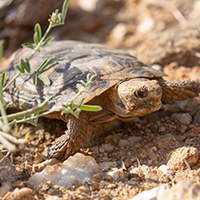
Range Extension for the Pancake Tortoise in Northeastern Kenya
Yvonne A. de Jong and Thomas M. Butynski
Eastern Africa Primate Diversity and Conservation Program, Nanyuki, Kenya
It took us only a second to realize what we were looking at. On the track in front of our Land Rover was a flat, turtle-like, creature scurrying from one rocky hill (or ‘kopje) to another. What we were seeing was an adult male Pancake Tortoise (or Crevice Tortoise Malacochersus tornieri). The Pancake Tortoise is referred to locally, in Kiswahili, as ‘Kobe kama Chapati’—Chapati Tortoise.

Adult male Pancake Tortoise (Crevice Tortoise) Malacochersus tornieri, northeastern Kenya.
According to the IUCN Red List of Threatened Species, the Pancake Tortoise is a ‘Critically Endangered’ species (Mwaya et al. 2019). Since this is the only species in the genus Malacochersus, this genus can also be considered to be ‘Critically Endangered’.
The Pancake Tortoise has a relatively soft and flexible shell that enables it to be considerably more agile than other tortoises. It is able to climb and slide down steep rocks (>30˚). Whereas most species of tortoise withdraw into their tough shell when threatened, the Pancake Tortoise makes a dash for it and wedges itself deep in a rock crevice or under a boulder. It wedges in with its carapace and claws and is extremely difficult to dislodge (Spawls et al. 2002, 2018). The individual that we encountered was surprisingly speedy and soon out-of-sight among the vegetation and rocks at the base of the hill.

Pancake Tortoise Malacochersus tornieri habitat, northeastern Kenya.

Pancake Tortoise Malacochersus tornieri habitat, northeastern Kenya.
The Pancake Tortoise is endemic to eastern Africa and has a very disjunct geographic distribution. It occurs in central northern and central southern Kenya, and in northern and central Tanzania. A small population is present in extreme northern Zambia. This diurnal species lives on and near small rocky hills and rock outcrops of the Precambrian Crystalline Basement System in semi-arid Acacia-Commiphora deciduous bushlands within the Somalia-Maasai and Zambezian Floristic Regions. Here the mean annual rainfall is 250–500 mm. The known altitudinal range is 400–1,800 metres above sea level. The diet of the Pancake Tortoise is comprised of flowers, herbs, grasses, and succulents, supplemented with seeds and arthropods (Spawls et al. 2002, 2018; Mwaya et al. 2019; Eustace et al. 2021).
Our brief encounter with this extraordinary species was during an antelope survey in northeastern Kenya. We will not, here, provide the location of our encounter with this Critically Endangered reptile because it is severely over-exploited by commercial collectors for the global exotic wildlife trade. We can report, however, that this individual was more than 100 km east of the currently known range (Mwaya et al. 2019; Eustace et al. 2021) at an altitude of 425 metres above sea level.

Adult male Pancake tortoise Malacochersus tornieri, northeastern Kenya.
The bizarre appearance of the Pancake Tortoise (flat, pancake-like dorsal-ventral profile, attractive shell), together with its relative agility and docility make it an attractive trade item for zoological and private collections. As a result, over-exploitation is a major threat to the long-term survival of this species, together with habitat degradation, loss, and fragmentation (Mwaya et al. 2019, Eustace et al. 2021). Climate change and severe drought are believed to be other causes of this species’ decline (Mwaya et al. 2019). Eustace et al. (2021) modelled climatic suitable habitats for Pancake Tortoises in current and future scenarios. Their models predict that the geographic range will expand and be more continuous under future climate change. Nonetheless, they warn that, since about 77% of the geographic range of this species lies outside of protected areas, the collection of wild individuals for the international exotic animal trade will remain a serious threat—even though this collecting is illegal in Kenya and Tanzania (Mwaya et al. 2019).
We plan to return to the site in which we found this one Pancake Tortoise in order to assess the limits of the area occupied and to obtain some indication of abundance.
We thank the Zoologische Gesellschaft für Arten- und Populationsschutz (ZGAP) for funding the Northeast Kenya Antelope Survey which led to the discovery of this Pancake Tortoise site.

Adult male Pancake Tortoise Malacochersus tornieri, northeastern Kenya.
References
Eustace, A., Esser, L.F., Mremi, R., Malonza, P.K. and Mwaya, R.T. 2021. Protected areas network is not adequate to protect a critically endangered East Africa chelonian: Modelling distribution of pancake tortoise, Malacochersus tornieri under current and future climates. PLoS ONE 16(1): e0238669.
Mwaya, R.T., Malonza, P.K., Ngwava, J.M., Moll, D., Schmidt, F.A.C. and Rhodin, A.G.J. 2019. Malacochersus tornieri. The IUCN Red List of Threatened Species 2019: e.T12696A508210. Website: <www.iucnredlist.org>
Spawls, S., Howell, K, Drewes, R and Ashe, J. 2002. A Field Guide to the Reptiles of East Africa. Academic Press, London.
Spawls, S., Howell, K., Hinkel, H. and Menegon, M. 2018. Field Guide to the East African Reptiles (2nd edition). Bloomsbury, London.

Adult male Pancake tortoise Malacochersus tornieri, northeastern Kenya.
Tags: Kobe kama Chapati, Malacochersus tornieri, northeast Kenya, pancake tortoise

